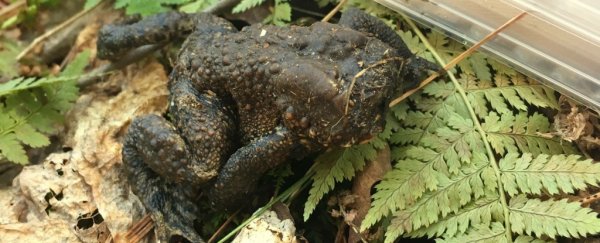Here's another one to chalk up to "nature, you freaky" - an adult toad found in a forest in Connecticut gave researchers a shock when they realised it was crawling about with no face.
Yep. No eyes, no nostrils, no jaw, and no tongue.
Just a faceless toad, bumbling into things, including the researchers' feet, according to University of Massachusetts herpetologist Jill Fleming, who found the toad in 2016.
She recently took to Twitter for an explanation of how the toad might have obtained such a bizarre injury.
Still puzzled by this find from 2016! An apparently “faceless” toad. Kept hopping into things. Had a small mouth hole- maybe esphogus/glottis (no maxilla or mandible, I think)? It was early spring so I think it must have come out of brumation like this. Any thoughts herp Twitter? pic.twitter.com/bFSLlakhs1
— Salamander Jill (Fleming) (@salamander_jill) February 27, 2018
There were no signs of an open wound, but the American toad's (Anaxyrus americanus) facelessness had to have been acquired, since it lacked the mouthparts for feeding, and there is no way (that we know of) that it could have survived to adulthood in that condition.
"My initial thought, which I still believe is a likely explanation, was that the extensive injury was inflicted by one of the toad's many natural predators during hibernation (for example, garter snakes or American mink)," Fleming told National Geographic.
"For whatever reason, the predator did not finish the job and the toad was able to become active again on that early spring day - amphibians are incredibly resilient."
If it got injured just before or during brumation (the cold-blooded animal version of hibernation), the toad would have been still enough for long enough that the traumatic injury healed over. If the toad had been active at the time, the story could have been very different.
Found the video. pic.twitter.com/cZJhDWEzOm
— Salamander Jill (Fleming) (@salamander_jill) February 27, 2018
Other things that could have caused the toad's loss of face include rodents, as per zoologist Collie Ennis, or a species of blow fly called Lucilia bufonivora (also known as toad fly). Adult toad flies commonly lay their eggs around the nostrils and eyes of toads; when the maggots hatch, they feed on the tissue surrounding them.
However, it's not known if toad flies can cause such extensive damage that even the toad's jaw would fall off.
Whatever it was that caused the damage, left the toad enough of its brain stem to keep its body functioning, albeit clumsily.
This has also been observed in the case of a chicken named Mike, who lived in the 1940s - after the animal was beheaded, it survived for nearly two years with his owner syringing food down his neck.
The researchers let the toad be and didn't collect it - but it probably didn't last much longer after this encounter.
"I have never seen anything with a head injury this severe still capable of getting around like this toad was," Fleming said.
"It would not have been able to eat in this condition and was an easy target for predators."
